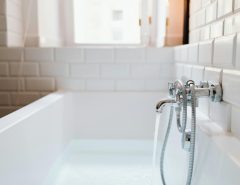Concrete is ideal for water tanks because it allows for custom-sized tanks and maintains a constant temperature throughout the year. In contrast, metal and plastic tanks might overheat in the summer sun. However, it is crucial to remember that concrete water tanks, such as cisterns and wells, are porous, whereas metal and plastic are not. As a result, concrete can become a breeding ground for algae, E. coli, and other bacteria, necessitating constant cleaning and disinfection.
Steps On Cleaning Your Concrete Water Tank
Six steps are outlined below in this page for cleaning your concrete water tank.
Cut the water supply off and drain it.
Any exterior water supply valves should be closed. You’re set if it’s a rainwater collection system. You must now drain the tank to clean it. While the water supply appears limitless, shortages are becoming more severe and frequent. That is why there are times where you need to call the most reliable services for bulk water delivery Ontario has to offer. Watering grass, washing automobiles, and other gray-water-safe activities are permitted even if the water is unfit for human consumption.
If it is not possible to conserve water, it should be drained away from structures to avoid oversaturating the earth and flooding basements and other areas.
Decontaminate the catchment area.
Clean the exterior of your system’s catchment cistern or tank first. Outside, scrub the tank with a 5-gallon bucket of soapy water and 12 cups of bleach. Rinse well.
Get inside.
Open the hatch that provides access to the tank. Certain tools are required. If cleaning the tank requires entering, authorities recommend obtaining confined space certification due to the possibility of trapped gasses or low oxygen levels. If you are required to enter the tank, keep a partner on duty in an emergency. Using a flashlight, search for clear sediments.
Disinfecting.
Add 1 cup of unscented home liquid bleach from 5% to 8.25 percent to a 10-gallon bucket halfway with water. With a stiff brush, scrub the interior of the tank thoroughly. Thoroughly rinse with clean water.
Cleaning the tank.
Even if you’re using bleach and water again, scrape the surface before disinfecting to eliminate any sediment or biofilms. The CDC suggests that you replenish it with potable water after cleaning your tank. They propose three cups of household liquid bleach with a concentration of 5% to 8.25 percent per 100 gallons of water for disinfection. Therefore, 15 cups of bleach are required for a 500-gallon tank. Allow 12 hours for the water-bleach mixture to settle.
From draining to drinking.
Drain the tank completely after soaking for at least twelve hours. Because bleach is corrosive to grass and plants, it should be disposed of in storm drains. Then run your faucets until the bleach odor is gone. On the other hand, other health boards propose repeatedly refilling and draining concrete tanks to eradicate the bleach, as concrete is porous and can hold it.
When adding potable water to the tank, use one tablespoon of bleach per 100 gallons to prevent microbial growth.
Conclusion
Experts recommend cleaning the concrete water tank at least once a year, if not twice a year. Additionally, water testing is recommended. Not assume that water that “appearances” to be clean is clean if it tastes terrible or causes stomach discomfort. By examining your water sample, water testing laboratories can detect microbiological concerns in three days or less. If it is not safe to use, empty it and repeat the process until it is.





